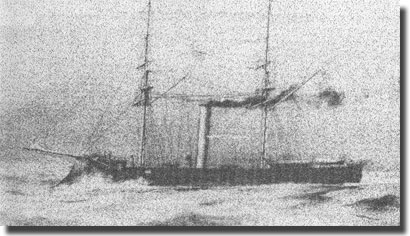|
Marauders of the Sea, Confederate Merchant Raiders During the American Civil War
CSS Stonewall. 1865. Captain T.J.Page. Civil War P99. CSS Stonewall.
On the 30th. of June, Bulloch was told that the Confederate Congress had appropriated $2 Million for building iron-clad-ships-of-war, and Mallory instructed him to contract with Arman for a ship, 172 feet long, 33 feet in her beam, to steam at 13 knots, and have 4.5 inches iron plate amidships, tapering to 3.5 inches at her extremities, and carry a 300 pounder Armstrong rifle in a forward turret, and two 70 pounder Armstrongs in an after turret. The ship had a ram, and was designed so that she might enter the Mississippi River, then a second ship with the same specifications was also ordered.
At this stage France was at war with Mexico, and the US were having the better of the Civil War, the persuasive Dayton induced Napoleon III to revoke the assurance he had imparted to both Bulloch and Slidell. The ship builders were told, the Iron clads could not sail, and the corvettes could not be armed in France but might be sold to a foreign merchant as ordinary trading vessels. All of course, a complete and bitter blow to the Confederacy, and her Navy. By the 9th. of July 1864, Arman indicated all six ships had been sold, only one came into the hands of the Confederacy, the iron-ram Sphynx, was sold to Denmark. At the time of this sale, Denmark was at war with Prussia, by the time this ship was delivered, the war was over, and the Danes wanted to be rid of her. The Confederates did a deal, and on the 6th. of January 1865 she sailed out of Copenhagen with Captain T.J.Page in command, and met up with a steamer, City of Richmond off the French coast, she carried the remainder of the officers and crew, plus necessary supplies, up went the Confederate flag, and she was named CSS Stonewall. The ship was forced into Ferrol, Spain to repair a leak, now Union warships were Civil War P100 waiting at Corunna, a short 9 miles from Ferrol. These were USS Niagara, one of the Union's fastest ships wit the formidable armament of 10, 150 pounder Parrott riffles, and the sloop, Sacramento, carrying two 1 inch guns, tow 9 inch, and one 90 pounder rifle, and overwhelming fire power when compared to the three guns mounted in the new iron clad Stonewall. On the 24th. of March, Page steamed out of Ferrol, in full view of the enemy, he was cleared for action and expected a fight to the death, he did everything to try and bring the Union ships to action, standing on and off all day. Commander Craven, the Captain of Niagara, was loath to commit his ships, he was scared of the iron clad Stonewall, fitted with a deadly ram against he wooden vessels, and he would not fight. Page ran out of patience, and sailed off, reaching Nassau on the 6th. of May, he went on to Havana, only to find the Civil War was finished, and surrendered his ship to the Captain General of Cuba, never destined to fire a gun in anger. The crew were paid off, discharged, and Spain delivered Stonewall to the US Government, they the sold the vessel to Japan, to end the life of the unfought and unloved Confederate ship of war. Commander Craven was brought to trial by court martial, on the charge of:
He was found guilty, and sentenced to two years suspension, but the Secretary of the Navy annulled the sentence, on the grounds that it was not sufficiently severe of the offence. On revision of the proceedings, the court martial made the same finding which the Secretary set aside, for the same reason and the accused was restored to duty. His defence was, that it would have been imprudent for him to risk his wooden vessels against the iron-clad ram. So, a farce ended the farce, first started off the shores of Spain.
back to Confederate Merchant Raiders index |


